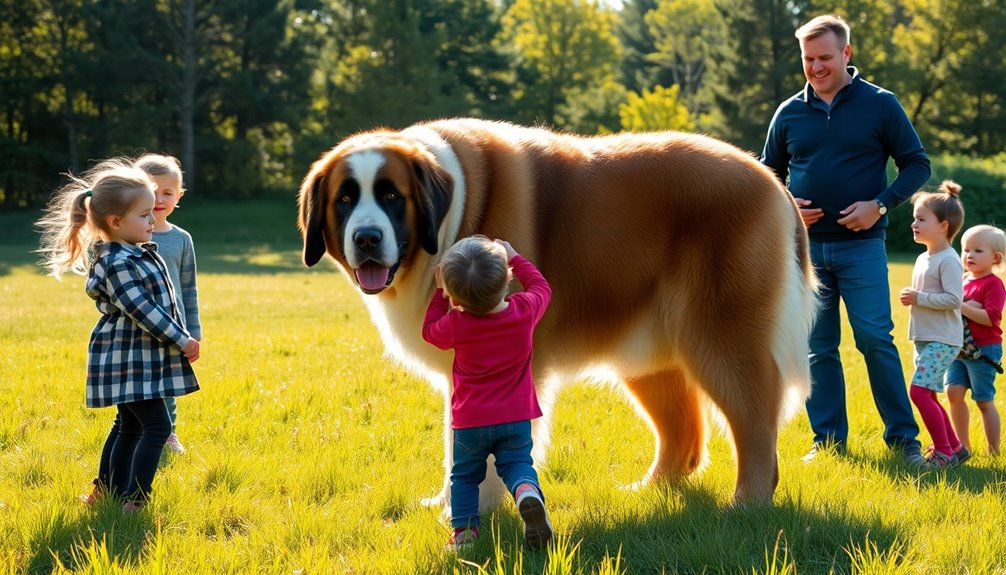The Saint Bernard is a gentle giant with a remarkable past. Weighing between 120 and 200 pounds, these dogs are known for their friendly demeanor and loyalty. Originating from the Swiss Alps, they were bred by monks for rescue missions, saving countless lives, especially in treacherous conditions. With their calm nature, they make excellent family companions, thriving on human interaction. However, they do require proper care, including training and regular exercise. If you're curious about their unique traits and what it takes to keep one happy, you'll find plenty more to explore about this incredible breed.
Key Takeaways
- Saint Bernards are large, gentle dogs weighing 120 to 200 pounds, known for their friendly demeanor and affectionate nature towards families.
- Originating from Roman Molossian dogs, they were bred by monks in the Swiss Alps for rescue operations during harsh winters.
- Their remarkable rescue skills were exemplified by the famous dog Barry, who saved over 40 lives in the early 1800s.
- Known as "gentle giants," they are calm and protective, making them excellent companions for children and other pets.
- Despite their impressive size, they require moderate exercise and thrive in spacious homes with outdoor access for optimal health.
Introduction

Nestled in the hearts of dog lovers everywhere, the Saint Bernard is more than just a breed; it's a gentle giant known for its remarkable temperament and striking appearance. Weighing between 120 to 200 pounds and standing 25 to 30 inches tall at the withers, this breed's size can be both awe-inspiring and intimidating.
Their medium-length double coat can be smooth or rough, featuring a beautiful array of colors like red and white, brindle and white, and various shades of brown and rust.
What truly sets the Saint Bernard apart is its temperament. With an incredibly gentle and friendly nature, these dogs are affectionate and loving towards their families. Their strong protective instinct makes them particularly attentive to children, ensuring a safe and calm environment. These dogs require only 20 minutes of exercise per day, making them a great choice for families with a more laid-back lifestyle.
This calm demeanor, combined with their loyalty and eagerness to please, makes them ideal companions for families.
However, owning a Saint Bernard comes with responsibilities. You'll need to be aware of their health needs, including proper nutrition and exercise, while also ensuring they get the socialization and training they need to thrive.
Embracing the joy of having a Saint Bernard means committing to their well-being and happiness.
History and Origin

The Saint Bernard breed traces its roots back to the ancient Romans, who brought molosser-type dogs into the Alps.
Known for their impressive rescue abilities, these dogs became heroes in avalanche-prone areas, guiding and saving lost travelers. Their remarkable skills were honed through approximately 200 years of service at the Hospice, where they performed thousands of rescues.
As you learn about their history, you'll discover how their role evolved from guardians in a monastery to celebrated rescue companions.
Where and when the breed originated
Saint Bernards trace their origins back to the Roman Molossian dogs, large canines brought to the Swiss Alps by the Roman army during their conquests. These formidable dogs were bred with local Swiss breeds, resulting in a strong, resilient lineage.
You'll find their ancestors include other mastiff-type dogs and local farm dogs, which were utilized for guarding and herding tasks.
The breed truly began to take shape at the Great St. Bernard Hospice, founded in 962 by Bernard of Menthon. Monks at this hospice, located on the treacherous Great St. Bernard Pass, acquired their first dogs between 1660 and 1670.
They selectively bred these dogs to enhance their natural abilities, focusing on strength, direction, and cold resistance. The geographical context of the pass, a crucial route through the Western Alps, played a vital role in the breed's development. Its harsh climate and frequent snowstorms necessitated the creation of robust and adaptable dogs.
Through careful breeding and historical circumstances, Saint Bernards emerged as reliable companions for travelers navigating this challenging terrain, marking the beginning of their storied legacy. Furthermore, the breed's reputation for exceptional rescue skills was solidified by famous individuals like Barry, who saved numerous lives in the mountains.
Rescue and Avalanche Assistance
Throughout history, countless lives have been saved thanks to the remarkable rescue efforts of Saint Bernards in the treacherous terrains of the Alps. Beginning in the early 18th century, monks at the hospice on the Great St. Bernard Pass trained these gentle giants to locate and assist travelers buried under snow.
During significant military events, like Napoleon's crossing in the early 1800s, these dogs played a crucial role, credited with saving over 2,000 lives. Using their keen sense of smell, they'd find victims and dig them out from the snow. Once they located someone, they provided warmth by lying on top of the injured, while one dog would race back to alert the monks. The monks then followed with sleds to transport those who couldn't walk due to injury or frostbite. Additionally, the average of 80,000 avalanches occur annually in the Swiss Alps, highlighting the ongoing need for such heroic efforts.
Despite facing numerous challenges, including the risk of avalanches that caused many dogs to perish, their legacy endures. The last documented rescue occurred in 1897, showcasing the unwavering dedication of Saint Bernards in mountain rescue.
Today, they symbolize hope and courage, influencing modern search and rescue missions around the world.
Physical Characteristics

When you look at a Saint Bernard, you can't help but notice their impressive size and muscular build, which can weigh between 120 to 180 pounds. Their expressive brown eyes draw you in, reflecting both gentleness and strength. Coupled with a thick double coat that varies in color, these gentle giants truly stand out in any setting. Their broad, powerful head and large feet contribute to their strong physical presence.
Size, weight, and coat details
Typically, St. Bernards are impressive in size, with males weighing between 140-180 pounds and females ranging from 120-140 pounds. If you're considering adopting one, keep in mind that at 8 months, males typically weigh 100-120 pounds, while females are around 85-110 pounds. Adult males stand about 28-30 inches tall at the shoulder, while females reach approximately 26-28 inches. Their growth continues until they're 2-3 years old, with 8-month-olds reaching about 75% of their mature height. This rapid growth is especially notable in the puppy stage, where they gain an average of 2-5 lbs per week.
In terms of coat, St. Bernards have a dense, insulating double coat that keeps them warm in cold weather. The outer coat is thick and resilient, while the undercoat is short, dense, and soft.
You'll find them in two varieties: shorthaired and longhaired. The shorthaired version has a uniform short coat, except for the thighs and tail. Their coats can display slight waviness, especially over the loin and pelvis, and they come in a range of stunning colors, including white with red, brindle, or mahogany markings.
Patterns like mahogany and white or brindle and white are quite common, adding to their distinctive charm.
Large, Expressive Brown Eyes
The large, expressive brown eyes of a Saint Bernard instantly convey their gentle nature and intelligence. Typically dark brown, these eyes are the standard for the breed, radiating warmth and friendliness. You'll notice that their eyes are set more to the front than the sides, giving them an alert and engaging appearance. Medium-sized and moderately deep-set, they contribute to the breed's distinctive look.
The eyelids, which don't close completely, create a slight angular wrinkle that adds to their character. While excessive skin can lead to eyelid issues, a healthy Saint Bernard maintains a kind and gentle expression. The eyes align perfectly to showcase their intelligence, making them seem almost human-like in their understanding. Additionally, their large size often complements their expressive features, enhancing their overall charm.
You'll appreciate how the deep-set eyes, combined with a wrinkled brow and short muzzle, enhance their overall friendly demeanor. Be cautious, though; blue eyes are uncommon and often indicate underlying genetic concerns.
A Saint Bernard's eyes should always be a reflection of their gentle spirit, reminding you of the breed's heroic past and their loving presence in your life.
Temperament and Personality

When you think of a Saint Bernard, picture a dog with a gentle and patient demeanor that makes them perfect for families and individuals alike. Their calm nature allows them to coexist harmoniously with children and other pets, ensuring a loving environment. You'll find that this breed thrives on companionship, forming strong bonds with their human family. Their protective instincts make them not only loving companions but also excellent guardians for children.
Gentle and Patient Demeanor
Saint Bernards often exude a gentle and patient demeanor that makes them beloved family companions. Their calm and affectionate temperament shines through, earning them the nickname "gentle giants."
Despite their large size, you'll find them to be incredibly affectionate and demonstrative, especially with family members. They're generally good with other household pets and aren't aggressive by nature.
One of their standout traits is their exceptional patience, which makes them excellent family friends and therapy dogs. Often referred to as "nanny dogs," they interact patiently with children, providing a calming presence.
Their low energy level means they move slowly and prefer a relaxed lifestyle, making them easy to have around. While they can be reserved around new people, they warm up quickly with proper introductions.
Socially, they're friendly toward strangers, though they might initially bark as a form of caution. Their sheer size and deep bark can deter intruders.
With early socialization and training, these dogs harness their good-natured temperament, thriving on human companionship. Just remember, they may experience separation anxiety if left alone for long periods. Additionally, they have a high tendency to drool, which may require regular cleanup to maintain a tidy environment.
Suitability for families, individuals, or other pets
How well do Saint Bernards fit into various living situations? These gentle giants excel in family environments, thanks to their affectionate nature and kid-friendly temperament. They bond closely with family members, but supervision is essential, particularly around small children, to prevent accidental knocks from their large size.
While they might nip occasionally, early training and socialization can mitigate this behavior.
For individuals, Saint Bernards make loyal companions, thriving on human interaction. Their low energy level suits those who prefer a less active pet, but keep in mind they need plenty of attention and are best for those with some dog experience. Their high energy needs may require more structured activities to keep them mentally stimulated, even if they enjoy lounging around.
Their limited heat tolerance also suggests they fare better in cooler climates.
When it comes to other pets, Saint Bernards generally integrate well into multi-pet households, especially if properly socialized. They don't have a strong prey drive, reducing the likelihood of chasing smaller animals.
However, it's wise to supervise them around unfamiliar pets and introduce them carefully.
Health and Lifespan

When you own a Saint Bernard, it's important to know their typical lifespan ranges from 8 to 10 years, which is shorter than many other breeds. They can face several health concerns, including bone cancer and skin conditions, which you should keep an eye on. Regular veterinary care is essential for monitoring health to ensure they live a longer and healthier life.
Typical lifespan of the breed
The typical lifespan of a Saint Bernard ranges from 8 to 10 years, reflecting the general trend seen in large and giant dog breeds. These gentle giants mature and age faster than smaller breeds, which often leads to a shorter lifespan. Compared to other large breeds, Saint Bernards typically live about 2 years less and 5 years less than medium-sized dogs.
A variety of factors influence their lifespan, including genetics, environment, and the care you provide. Proper nutrition is crucial; feeding high-quality dog food formulated for giant breeds ensures they develop healthily. Additionally, monitoring for common health issues like hip dysplasia and bloat is essential for their longevity.
Regular exercise helps maintain their overall well-being, while routine veterinary check-ups and vaccinations are vital for preventive care. Moreover, avoiding obesity through careful feeding practices can significantly extend their lives.
Providing a stress-free environment, adequate space, and mental stimulation also contributes to their happiness and longevity. Neutering or spaying your Saint Bernard may help prevent certain health issues, while early detection of potential problems through regular vet visits is essential.
Common health concerns or genetic predispositions
While owning a Saint Bernard can bring immense joy, it's essential to be aware of the common health concerns and genetic predispositions that may affect this breed. One significant issue is genetic neuromuscular disorders, such as laryngeal paralysis and polyneuropathy. These conditions can lead to noisy breathing, exercise intolerance, and muscle wasting. With around 20% of Saint Bernards being carriers, awareness is crucial. Additionally, early detection of laryngeal paralysis can aid in management and care decisions.
Cardiovascular health is another concern, particularly dilated cardiomyopathy (DCM), a serious heart condition that can cause weakness and labored breathing. Regular ECGs and echocardiograms starting at age one can help catch this early.
Additionally, joint issues like hip and elbow dysplasia are prevalent, affecting nearly 50% of the breed. These problems can lead to arthritis and mobility issues, impacting your dog's quality of life.
Lastly, dental disease is common, with 80% of dogs affected by age two. This can result in infections that may shorten your pet's lifespan. Regular dental care and vaccinations are vital to keeping your Saint Bernard healthy and happy.
Tips for maintaining health and wellness
Maintaining the health and wellness of your Saint Bernard is vital for ensuring a long, happy life. Start by providing high-quality protein sources like chicken, beef, and fish to support muscle maintenance. Additionally, consider incorporating a raw food diet that promotes overall health and happiness in dogs. Turmeric's potent relief for osteoarthritis pain can also be beneficial in older dogs that may experience joint issues.
Balance their diet with healthy fats, including omega-3 and omega-6 fatty acids, which promote skin and coat health. Incorporate carbohydrates and fiber from whole grains, vegetables, and fruits for energy and digestive health.
Regular exercise is essential for your Saint Bernard's bone and joint health, so establish a structured routine that includes gentle activities like short walks. Be cautious not to overexert them, as large breeds are prone to exhaustion.
Grooming is equally important; brush their thick coat several times a week to manage shedding, clean their ears to prevent infections, and maintain dental health through regular care.
Don't forget to trim their nails to avoid mobility issues.
Finally, schedule regular veterinary visits for vaccinations, heart screenings, and preventive care. Dietary adjustments may be necessary based on your dog's specific health needs.
Care Requirements

Caring for a Saint Bernard involves regular brushing to keep their thick coat healthy and manageable. To maintain their coat, it's essential to use a slicker brush for removing dead hairs. You'll also need to provide them with daily exercise to match their energy levels and prevent boredom. Finally, focusing on a balanced diet will ensure your gentle giant stays fit and happy.
Regular Brushing Required
Regular brushing is essential for keeping your Saint Bernard's coat in top condition. Aim to brush at least three times a week to manage shedding and prevent matting. During shedding seasons, you might need to brush every other day or even daily. Using a slicker brush or an undercoat rake is crucial for effectively handling their double coat.
Brushing not only helps control shedding but also distributes natural oils, keeping your dog's coat healthy and shiny. It's a great opportunity to check for skin issues or parasites. Always brush in the direction of hair growth to avoid tangling, and if you encounter mats, gently work them out with your fingers or cut them out with straight shears if they're severe.
For puppies, use a soft brush to help them get used to grooming. Adult Saint Bernards need more intensive brushing due to their denser fur, while seniors require gentle care with a focus on checking for any lumps or irritations. Additionally, regular grooming is essential for maintaining your dog's overall health.
Regular brushing makes grooming easier and keeps your gentle giant looking and feeling great!
Exercise requirements and energy levels
Saint Bernard owners should be mindful of their gentle giant's exercise requirements to ensure a happy and healthy life. These dogs need moderate exercise, as their size makes excessive strain unwise. A long daily walk at a brisk pace typically meets their physical needs. Incorporate play sessions, like tossing a ball, for about 30 minutes to get their heart rate up.
Be cautious not to overexert them, especially in hot weather, as their heavy double coats can lead to overheating. Avoid activities that promote jumping to prevent injuries that can occur from hard landings.
While Saint Bernards have a calm demeanor indoors, they still require regular physical and mental stimulation. Although they're not as energetic as some breeds, they can be somewhat lazy, so encourage them to engage in walks and playtime.
Mental stimulation is essential, so consider interactive games and puzzle toys to keep their minds sharp.
For puppies, restrict high-impact activities and keep play on soft ground to protect their developing joints. Gradually increase exercise duration as they grow, and avoid long walks until they're around two years old.
Regular veterinary checks will help monitor their health and prevent joint issues common in large breeds.
Feeding tips and diet recommendations
Feeding your Saint Bernard requires careful attention to their unique nutritional needs to keep them healthy and thriving. Start with high-quality protein sources like chicken, beef, lamb, or fish, as they're essential for maintaining muscle mass. Include balanced fat content, particularly omega-3 and omega-6 fatty acids, to support energy and skin health. Additionally, incorporating high-quality ingredients in their diet ensures they receive the necessary nutrients for optimal health.
Carbohydrates and fiber from whole grains, vegetables, and fruits provide energy and aid digestion. A structured feeding schedule is crucial—adults typically eat two meals daily, while puppies may need 3-4 smaller meals. Adjust portion sizes based on age, weight, and activity level, aiming for about 5-10 cups of dry food daily for adults.
To prevent bloat, avoid one large meal and restrict exercise before and after feeding. For seniors, consider lower-calorie diets with higher fiber to support joint health. Always choose high-quality ingredients, with real meat as the first ingredient.
Consult your veterinarian for personalized dietary advice, and consider slow-feeder bowls if your dog eats too quickly. With proper nutrition, your gentle giant will lead a happy, healthy life.
Training and Socialization

Training your Saint Bernard requires patience, especially since they're moderately responsive to commands. Gradual introductions to new friends are essential for their socialization, helping them feel comfortable in different situations. You'll also need to manage leash pulling during walks to ensure a pleasant experience for both of you. Incorporating positive reinforcement during training sessions will enhance their learning and make the process more enjoyable for both you and your dog.
Moderately Responsive to Commands
When it comes to training, Saint Bernards exhibit a moderately responsive nature to commands, which means patience and consistency are key. To effectively train your Saint Bernard, focus on using positive reinforcement techniques. Reward good behavior with high-value treats, praise, or favorite toys instead of resorting to physical punishment or yelling.
Clicker training can also be beneficial, as it helps you mark the exact moment your dog performs the desired action. Keep training sessions short and engaging, about 5-10 minutes, to match your dog's attention span. Create a solid training plan and ensure everyone in your household follows the same commands and rules. Socialization is crucial for preventing shyness and ensuring your Saint Bernard interacts well with others. Additionally, incorporating visualization techniques can enhance your training sessions by helping both you and your dog connect more deeply during practice.
Consistency will help prevent confusion and reinforce learning. Supervise training sessions closely to correct behaviors immediately, and involve children in the process under adult supervision. Start by teaching basic commands like "sit," "stay," and "come."
Socialization from a young age is essential, so consider enrolling in puppy classes for structured learning. Remember, correcting unwanted behavior promptly is crucial, but always maintain a calm demeanor. With patience and persistence, you can help your Saint Bernard become a well-behaved companion.
Gradual Introductions to New Friends
Socialization is vital for your Saint Bernard's development, shaping their ability to interact confidently with new friends. Start this process between 8 to 14 weeks old for optimal results. Introduce your puppy to various people, animals, and environments to ensure they develop well-rounded social skills. Use positive reinforcement techniques, like treats and verbal praise, to create positive associations.
Gradually expose your puppy to new environments, textures, and sounds to prevent sensory overload. Encourage interactions with individuals of all ages, sizes, and backgrounds. Reward calm behavior during these encounters, and teach polite greetings to avoid jumping or aggressive behavior. Incorporate basic commands like "sit," "stay," and "come" during socialization exercises to reinforce good manners. Additionally, be aware that Saint Bernards' gentle temperament makes them particularly suited for family interactions.
Begin in a controlled environment at home before venturing into less familiar settings. Puppy socialization classes offer a safe space for interacting with other dogs. Make sure all interactions with the vet and groomer are positive to build trust and reduce anxiety.
Consistency is key—maintain a routine in your socialization activities, and keep training sessions short and engaging to hold your puppy's interest.
Leash Pulling During Walks
Leash pulling can turn a simple walk into a frustrating experience for both you and your Saint Bernard. To tackle this issue, start with basic commands like "sit," "stay," and "come." Establish a solid training foundation using positive reinforcement techniques. Reward good behavior with treats, praise, or affection, especially when your dog walks calmly on the leash.
Begin training in a distraction-free environment to help your Saint Bernard focus. Keep training sessions short and frequent to match their attention span. Consistency is key—use the same commands and rewards each time. If your dog pulls, stop walking immediately. Wait for them to calm down before continuing. This method reinforces the idea that pulling does not lead to forward movement.
Consider using a no-pull harness to manage leash pulling effectively. Encourage your dog to walk on your left side using food rewards and consistent commands. Incorporate reverse following exercises to redirect their focus on you.
Lastly, practice patience. Saint Bernards can be stubborn, so avoid punishment or yelling, which can increase anxiety. If you need extra guidance, don't hesitate to seek professional help through online dog training courses for personalized techniques.
Ideal Living Environment

If you're considering a Saint Bernard, you'll want a spacious home with easy outdoor access. These gentle giants thrive in cooler, mountainous climates where they can enjoy plenty of fresh air. Providing them with room to roam and explore is essential for their well-being. Additionally, due to their large size, they require ample space to move comfortably within the home.
Spacious Home With Outdoor Access
A spacious home with outdoor access is essential for a Saint Bernard, allowing this gentle giant to thrive. These dogs require ample space inside your house to move around comfortably, so a large home or apartment is ideal.
When planning travel, you'll need a sizable vehicle to accommodate their size, ensuring they can travel safely and comfortably.
Outdoor access is equally important. Your Saint Bernard benefits from having a secure yard or garden where they can explore, relax, and enjoy fresh air. This access helps manage their curious nature while promoting their mental and physical well-being. Additionally, their gentle temperament makes them great companions for families with children and other pets.
Aim for outdoor areas that allow safe roaming, as they need about an hour of interactive play or walking each day. Two walks of at least 30 minutes each, along with activities like tug games and swimming, will keep them healthy and content.
Additionally, a very soft bed with good support is crucial for their comfort, and grooming should be a regular part of your routine, especially during shedding seasons.
Prefers Cooler, Mountainous Climates
Saint Bernards thrive best in cooler, mountainous climates, reflecting their origins in the Swiss Alps. Ideally, they prefer temperatures between 20°C and 27°C (68°F to 80°F). When the mercury rises above the mid-80s, they can become uncomfortable and even suffer from heat-related health issues.
Their thick, double-layered coats are designed for cold weather, so ensuring a cool environment is essential. Adequate ventilation and air circulation are crucial for their well-being, as these elements help regulate their body temperature.
To keep your Saint Bernard comfortable, provide shaded areas outdoors, and make sure they've plenty of fresh water, especially during hot days. Incorporating cooling methods like misting systems or kiddie pools can help them beat the heat.
Indoors, air conditioning or fans are necessary to prevent heat build-up, while avoiding strenuous activities during peak heat hours is crucial.
When outdoors, make sure they've shaded play areas and secure fencing to protect them from sudden weather changes. It's also wise to landscape with native plants and grass to help keep the temperatures lower.
Always monitor your pup for signs of discomfort, and prioritize their well-being to ensure a happy, healthy life in your cooler, mountainous home.
Famous for Saving Lives

When you think of Saint Bernards, their heroic role as rescue dogs in the Swiss Alps likely comes to mind.
These gentle giants not only saved countless lives but also captured the hearts of many, including Beethoven, who famously had a Saint Bernard as a companion. Their history as avalanche rescue dogs showcases their incredible skills and unwavering loyalty. Their legacy of bravery and devotion continues to inspire admiration to this day.
Rescue Dogs in Swiss Alps
Throughout history, these remarkable dogs have played a vital role in the rescue operations of the Swiss Alps, showcasing their incredible abilities and unwavering loyalty. Bred by Augustinian monks at the Great St. Bernard Pass since the 11th century, Saint Bernards were initially guardians and pack animals. Their impressive size and thick fur made them perfect for navigating the harsh alpine environment.
As avalanche search dogs, they became essential in locating stranded travelers buried in snow. Working in pairs or small groups, they were faster and more effective than humans alone. With their keen sense of smell, they could detect victims, while their powerful paws dug them out. Often, one dog would stay with the rescued person to provide warmth, while another sought help. These dogs are known for their exceptional skills and bravery, which contributed to their legendary status.
One of the most famous rescue dogs, Barry, saved over 40 lives between 1800 and 1812, earning the title "Barry der Menschenretter." Collectively, these dogs saved over 2,000 lives, cementing their legacy as heroes of the Swiss Alps.
Though their role in mountain rescues ended by the late 1800s, their spirit lives on as a symbol of hope and courage.
Beethoven's Canine Companion
Many people might recognize Beethoven, the lovable Saint Bernard from the popular film series, as a charming family pet. However, this breed has a heroic past that extends far beyond the screen.
Historically, Saint Bernards served as rescue dogs in the treacherous Swiss Alps, saving countless lives. Take, for instance, Barry, a legendary Saint Bernard who saved over 40 travelers between 1800 and 1812. His remarkable skills included locating buried individuals using his keen sense of smell and providing warmth by lying on top of them. This breed's unwavering loyalty and instinctive trust issues with their handlers enabled them to forge strong bonds that enhanced their rescue capabilities.
These dogs were more than just rescuers; they acted as an alert system. One would return to the hospice to inform monks about stranded travelers, enabling prompt rescue efforts. The monks would then follow the dogs to retrieve victims, often using sleds for transportation. In fact, the dogs' effectiveness in rescues was critical during the treacherous snowstorms that challenged many travelers in the Alps.
Saint Bernards also played crucial roles in guiding and guarding travelers, showcasing their versatility and loyalty.
While Beethoven may have captured hearts in Hollywood, the breed's real-life legacy of bravery and resilience continues to inspire admiration around the world. Today, the heroic image of the Saint Bernard reminds us of their vital contributions to saving lives in harsh conditions.
Gentle Giant for Spacious Homes?

Gentle Giant for Spacious Homes?
If you're considering a Saint Bernard, keep in mind they thrive in spacious family homes where they can move comfortably. Regular outdoor access is crucial for their well-being, as these dogs benefit from moderate daily exercise. Their grooming needs and shedding frequency also require some attention, so be prepared for regular brushing sessions. With enough room and care, this gentle giant can be a wonderful addition to your family.
Ideal for Large Family Homes
Saint Bernards, often affectionately referred to as "gentle giants," thrive in large family homes where they can comfortably stretch their legs and enjoy their surroundings. Given their size, with adult males weighing up to 180 pounds or more, they need ample room to prevent discomfort and stress. Cramped spaces may lead to health issues like joint problems, so having spacious indoor and outdoor areas is ideal.
While they require moderate exercise—about 30 minutes a day—a long daily walk at a brisk pace usually suffices. You can break exercise into two or three shorter sessions, incorporating playtime to keep their heart rate up. This helps prevent obesity and other health concerns. Regular exercise is essential to maintaining their large frame, which contributes to their overall health.
Their friendly and affectionate nature makes Saint Bernards excellent family pets. They bond strongly with their families and do well with children, thanks to their protective disposition. Early socialization and training are crucial, especially when interacting with small children to prevent accidental injuries.
In addition, a fenced yard allows them to explore safely, while cooler climates are preferred.
Grooming Needs and Shedding Frequency
How can you keep your Saint Bernard looking their best while managing their shedding? Regular grooming is key. Brush your dog 2-3 times a week for maintenance, but ramp it up to daily during shedding seasons in spring and fall.
For long-haired St. Bernards, use a slicker brush to detangle and prevent matting. If you have a short-haired variety, a grooming rake or de-shedding tool will help reach the undercoat effectively. Regular grooming helps manage shedding, especially during seasonal changes.
Daily brushing during shedding periods is crucial to manage the significant amounts of loose fur. This not only reduces shedding around your home but also helps eliminate dirt and dust, cutting down on bath time.
You should bathe your Saint Bernard every 2-3 months, or sooner if they get dirty.
Don't forget about other grooming tasks: trim the fur on their feet and between the pads, check their ears for debris, and ensure their nails are trimmed monthly.
Additionally, keep an eye on tear stains and wipe them with a damp cloth. Consistent grooming is essential for maintaining your gentle giant's health and appearance.
Frequently Asked Questions
What Is the Average Cost of a Saint Bernard Puppy?
The average cost of a Saint Bernard puppy ranges from $1,000 to $1,500, but you might find prices as low as $550 or as high as $3,500, depending on factors like breeder reputation and puppy lineage.
If you're considering adopting, fees can range from $100 to $500.
Keep in mind, initial and ongoing expenses, including food, vet visits, and grooming, will also impact your budget throughout your dog's life.
Do Saint Bernards Shed a Lot?
Yes, Saint Bernards do shed quite a bit.
They've a thick double coat that sheds year-round, with heavier shedding in spring and fall.
You'll want to brush them regularly, ideally daily during peak shedding times, to manage the loose hair and prevent matting.
Keeping an eye on their grooming needs will help maintain their coat's health and minimize the mess in your home.
How Much Exercise Does a Saint Bernard Need Daily?
A Saint Bernard needs at least an hour of exercise daily once fully grown.
You can break this into shorter sessions throughout the day, focusing on moderate activities like walks, playtime, and brain games.
Be mindful of their joints, so avoid high-impact exercises.
It's best to exercise during cooler times to prevent heat stress.
Don't forget to include mental stimulation to keep them engaged and happy!
Are Saint Bernards Good With Children?
Yes, Saint Bernards are generally great with children. Their gentle and patient nature makes them loving companions, even with the rough play that kids often engage in.
However, you'll want to supervise their interactions to ensure safety due to their large size. Socialization and training are crucial, so teaching your kids how to interact safely with your Saint Bernard will help foster a harmonious relationship.
What Food Is Best for a Saint Bernard?
When choosing food for your Saint Bernard, focus on high-quality protein sources like chicken or beef, aiming for 18-25% protein content for adults and 22-24% for puppies.
Balance their diet with healthy fats, like omega-3s, and carbohydrates from whole grains and vegetables. Ensure they get essential vitamins and minerals for overall health.
Don't forget to adjust portions based on age and activity level to prevent obesity and support their well-being.
Conclusion
In conclusion, the Saint Bernard is more than just a gentle giant; it's a loyal companion with a rich history of heroism. Their affectionate nature and impressive size make them perfect for spacious homes where they can thrive. With the right training and socialization, you'll discover a loving friend that enriches your life. If you're ready for a devoted and protective addition to your family, this remarkable breed could be the perfect fit for you.










